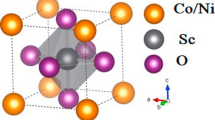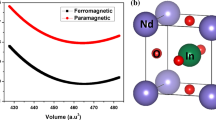Abstract
Spinel oxides have attracted huge attention from researchers owing to their fundamental potential and applied prospects. In particular, it is highly desirable to enhance simultaneously the transparent and conducting nature of spinel oxides for many device applications such as display screens. To achieve the task, we report a comparative analysis on the spin-polarized electronic and optical properties of manganese-indium-dioxide (MnIn2O4) spinel and its Cd-doped counterparts MnIn2−xCdxO4 (x = 0.25, 0.50, 0.75, 1). For the quantum-computation analysis of the required properties, we apply density functional theory within Tran-Blaha Modified Becke–Johnson functional to account for electronic exchange correlation. The calculated energy bandgap of MnIn2O4 is 0.8 eV for majority spin and 1.2 eV for minority spin. We observe a considerable modification in bandgap of MnIn2O4 with Cd-doping concentration along with the enhancement of intensity of DOS (density of states) near \(E_{F}\) level. The maximum bandgap of 1.8 eV and 2.1 eV is predicted for majority and minority spin for the compound MnInCdO4. The Cd doping-assisted enhancement of bandgap and DOS near \(E_{F}\), significantly modified the transparency and conductivity in MnInCdO4 at specific energy.








Similar content being viewed by others
Data Availability Statement
This manuscript has associated data in a data repository. [Authors’ comment: Data is availbe on reasonable request to the corresponding author].
References
K.E. Sickafus, J.M. Wills, N.W. Grimes, Structure of spinel. J. Am. Ceram. Soc. 82(12), 3279–3292 (1999)
H. Choi, J. Shim, B. Min, Electronic structures and magnetic properties of spinel Zn Mn2O4 under high pressure. Phys. Rev. B 74(17), 172103 (2006)
V.G. Harris, Microwave magnetic materials, in Handbook of Magnetic Materials. (Elsevier, 2012), pp.1–63
T. Tatarchuk, B. Al-Najar, M. Bououdina, M.A.A. Ahmed, Catalytic and Photocatalytic Properties of Oxide Spinels, in Handbook of Ecomaterials. ed. by L.M.T. Martínez et al. (Springer International Publishing AG, New York, 2018)
J.A.M. Gamboa et al., A figure of merit to evaluate transparent conductor oxides for solar cells using photonic flux density. Thin Solid Films 599, 14–18 (2016)
T.M.W.J. Bandara et al., Transparent and conductive F-Doped SnO2 nanostructured thin flms by sequential nebulizer spray pyrolysis. MRS Adv. 6, 417–421 (2021)
G.K. Dalapati et al., Tin oxide for optoelectronic, photovoltaic and energy storage devices: a review. J. Mater. Chem. A 9, 16621–16684 (2021)
A.V. Sanchela et al., Optoelectronic properties of transparent oxide semiconductor ASnO3 (A = Ba, Sr, and Ca) epitaxial films and thin film transistors. J. Vac. Sci. Technol., A 40, 020803 (2022)
Z. Wang et al., Transparent conductive oxides and their applications in near infrared plasmonics. Phys. Status Solidi A 216, 1700794 (2019)
S.H. Lee et al., Frustrated magnetism and cooperative phase transitions in spinels. J. Phys. Soc. Jpn. 79(1), 011004 (2010)
Y. He et al., Size and structure effect on optical transitions of iron oxide nanocrystals. Phys. Rev. B 71(12), 125411 (2005)
C.P. Poole, H.A. Farach, Magnetic phase diagram of spinel spin-glasses. Z. für Phys. B Condens. Matter 47(1), 55–57 (1982)
M.F. Bekheet, L. Dubrovinsky, A. Gurlo, Compressibility and structural stability of spinel-type MnIn2O4. J. Solid State Chem. 230, 301–308 (2015)
V. Zhandun, The magnetic, electronic, optical, and structural properties of the AB2O4 (A= Mn, Fe, co; B= Al, Ga, In) spinels: Ab initio study. J. Magn. Magn. Mater. 533, 168015 (2021)
K. Krezhov, Neutron diffraction assisted investigations in condensed matter physics and materials science at inrne–bas. Invited Papers, 2012, p. 31
M.F. Bekheet et al., Low temperature synthesis of nanocrystalline MnIn2O4 spinel. Dalton Trans. 41(12), 3374–3376 (2012)
M.F. Bekheet et al., Ferrimagnetism in manganese-rich gallium and aluminium spinels due to mixed valence Mn2+–Mn3+ states. Dalton Trans. 47(8), 2727–2738 (2018)
M.F. Indates, B.I. Pokrovskii, A.K. Gapeev, K.V. Pokholok, L.N. Komissarova, I.V. Igonina, A.M. Babeshkin, Soviet physics. Crystallography 17(4–6), 696 (1972)
N. Kimizuka, T. Mohri, Structural classification of RAO3 (MO) n compounds (R= Sc, In, Y, or lanthanides; A= Fe (III), Ga, Cr, or Al; M= divalent cation; n= 1–11). J. Solid State Chem. 78(1), 98–107 (1989)
M.M. Lope et al., Why MnIn2O4 spinel is not a transparent conducting oxide? J. Solid State Chem. 187, 172–176 (2012)
G.K.P. Palmer, T. Mason, Zn2− xSn1− xIn2xO4− δ: An indium-substituted spinel with transparent conducting properties. J. Solid State Chem. 134(1), 192–197 (1997)
N. Ueda et al., New oxide phase with wide band gap and high electroconductivity, MgIn2O4. Appl. Phys. Lett. 61(16), 1954–1955 (1992)
K. Chopra, S. Major, D. Pandya, Transparent conductors—a status review. Thin Solid Films 102(1), 1–46 (1983)
S. Akbudak et al., Structural, electronic, elastic, optical and vibrational properties of MAl2O4 (M= Co and Mn) aluminate spinels. Ceram. Int. 44(1), 310–316 (2018)
T. Zhang et al., Elastic and electronic properties of MnTi2O4 under pressure: a first-principle study. Comput. Mater. Sci. 84, 156–162 (2014)
Y. Huang, Z. Yang, Y. Zhang, Magnetic, transport, thermal properties and orbital state for spinel MnTi2O4. J. Magn. Magn. Mater. 324(13), 2075–2081 (2012)
F. Tielens et al., Periodic DFT study of the structural and electronic properties of bulk CoAl2O4 spinel. J. Phys. Chem. B 110(2), 988–995 (2006)
Y. Hou et al., Structural, electronic and magnetic properties of manganese substituted CoFe2O4: a first-principles study. J. Magn. Magn. Mater. 495, 165862 (2020)
A. Nadeem et al., First-principles quantum analysis on the role of V-doping on the tuning of electronic and optical properties of spinel oxides MnTi2O4. Mater. Sci. Eng., B 278, 115643 (2022)
J. Orton, Semiconductors and the Information Revolution (Elsevier, Amsterdam, 2009)
N. Dharmarasu, H. Hillmer, F.T. Mahi, Compound semiconductors in reference module in materials science and materials engineering. Mater. Adv. 24, 1–27 (2017)
N. Dharmarasu, H. Hillmer, Compound semiconductors in comprehensive microsystems, (2008) pp. 25–51
K. Burke, L. Wagner, ABC of ground-state DFT (University Lecture, Edinburgh, 2014)
P. Ziesche, S. Kurth, J.P. Perdew, Density functionals from LDA to GGA. Comput. Mater. Sci. 11(2), 122–127 (1998)
Z. Wu, R.E. Cohen, More accurate generalized gradient approximation for solids. Phys. Rev. B 73(23), 235116 (2006)
F. Tran, P. Blaha, Accurate band gaps of semiconductors and insulators with a semilocal exchange-correlation potential. Phys. Rev. Lett. 102(22), 226401 (2009)
K. Schwarz, P. Blaha, G.K. Madsen, Electronic structure calculations of solids using the WIEN2k package for material sciences. Comput. Phys. Commun. 147(1–2), 71–76 (2002)
D. Koller, F. Tran, P. Blaha, Merits and limits of the modified Becke-Johnson exchange potential. Phys. Rev. B 83(19), 195134 (2011)
J.P. Perdew, K. Burke, M. Ernzerhof, Generalized gradient approximation made simple. Phys. Rev. Lett. 77(18), 3865 (1996)
D.J. Singh, Structure and optical properties of high light output halide scintillators. Phys. Rev. B 82(15), 155145 (2010)
S.D. Guo, B.G. Liu, Improved half-metallic ferromagnetism of transition-metal pnictides and chalcogenides calculated with a modified Becke–Johnson exchange potential. EPL (Europhys. Lett.) 93(4), 47006 (2011)
M.G. Brik, A. Suchocki, A. Kaminska, Lattice parameters and stability of the spinel compounds in relation to the ionic radii and electronegativities of constituting chemical elements. Inorg. Chem. 53(10), 5088–5099 (2014)
P.E. Blöchl, Projector augmented-wave method. Phys. Rev. B 50(24), 17953 (1994)
B. Yıldız, A. Erkişi, and G. Sürücü, The mechanical and electronic properties of spinel oxides VX2O4 (X= Mn and Fe) by first principle calculations. in AIP Conference Proceedings. AIP Publishing LLC, 2019
K. Inomata et al., Highly spin-polarized materials and devices for spintronics. Sci. Technol. Adv. Mater. 9(1), 014101 (2008)
A. Wang et al., Indium-cadmium-oxide films having exceptional electrical conductivity and optical transparency: clues for optimizing transparent conductors. PNAS 98(13), 7113 (2001)
Y. Zhu, P. Lei, J. Zhu, J. Han, Influences of indium doping and annealing on microstructure and optical properties of cadmium oxide thin films. Appl. Phys. A. 122, 410 (2016)
W. Xie and H. Luo, Structure-property correlations and superconductivity in spinels in magnetic spinels–synthesis, Properties and Applications Editor Mohindar Seehra, (2017)
D. Segev, S.H. Wei, Structure-derived electronic and optical properties of transparent conducting oxides. Phys. Rev. B 71(12), 125129 (2005)
R. Singh, R.K. Ulrich, High and low dielectric donstant materials. Electrochem. Soc. Interface 8, 26–30 (1999)
R. Kumar et al., Overview on metamaterial: history, types and applications. Materilastoday Proc. 56, 3016–3024 (2022)
D.R. Penn, Wsve-number-dependent dielectric function of semiconductors. Phys. Rev. 128, 2093 (1962)
B. Hammer, L.B. Hansen, J.K. Nørskov, Improved adsorption energetics within density-functional theory using revised Perdew–Burke–Ernzerhof functionals. Phys. Rev. B 59(11), 7413 (1999)
P. Herve, L. Vandamme, Empirical temperature dependence of the refractive index of semiconductors. J. Appl. Phys. 77(10), 5476–5477 (1995)
H. Li, W. Chen, Stability of MnCr2O4 spinel and Cr2O3 in high temperature carbonaceous environments with varied oxygen partial pressures. Corros. Sci. 52(7), 2481–2488 (2010)
Y. Li et al., Pressure-tuning the nonlinear-optical properties of AgGaS2 crystal: a first-principle study. Opt. Mater. Exp. 5(8), 1738–1751 (2015)
T.-H. Ma et al., First-principles calculations of the structural, elastic, electronic and optical properties of orthorhombic LiGaS2 and LiGaSe2. Phys. B 405(1), 363–368 (2010)
S. Li et al., Fabrication of porous silicon nanowires by MACE method in HF/H2O2/AgNO3 system at room temperature. Nanoscale Res. Lett. 9(1), 1–8 (2014)
E. Martínez-Terán et al. Room temperature ferromagnetic MnCr2O4 spinel chromite nanoparticles. in APS March Meeting Abstracts, 2019
G. Sun et al., Performance of the Vienna ab initio simulation package (VASP) in chemical applications. J. Mol. Struct. Theory. Chem. 624(1–3), 37–45 (2003)
G. Haacke, New figure of merit for transparent conductors. J. Appl. Phys. 47, 4086 (1976)
T. Oda et al., Electron-phonon interaction, lattice dynamics and superconductivity of an oxide spinel LiTi2O4. J. Phys. Condens. Matter 6, 6997 (1994)
R. Padmavathy et al., Structural, electronic and mechanical properties of AgIn1− XGaXS2 (X= 0, 0.25, 0.50, 0.75, 1) chalcogenides. Indian J Phys 95(9), 1751–1756 (2021)
J.P. Perdew et al., Perdew et al. reply. Phys. Rev. Lett. 101(23), 239702 (2008)
S.-H. Song, Z.-X. Yuan, P. Xiao, Electrical properties of MnCr2O4 spinel. J. Mater. Sci. Lett. 22(10), 755–757 (2003)
G. Tan et al., Kramers-Kronig transform for the surface energy loss function. J. Electron Spectrosc. Relat. Phenom. 142(2), 97–103 (2005)
E. Winkler et al., Magnetocrystalline interactions in MnCr2O4 spinel. Phys. Rev. B 80(10), 104418 (2009)
K. Sturm, Electron energy loss in simple metals and semiconductors. Adv. Phys. 31(1), 1–64 (1982)
A. Nadeem et al., On the role of Zn doping on tuning the electronic and optical properties of MnCr2O4 spinel via Mn0.5Zn0.5Cr2O4 doping scheme: a first-principles quantum computational analysis. Phys. Scripta 97(4), 045812 (2022)
K.H.L. Zhang, P-type transparent conducting oxides. J. Phys. Condens. Matter 28, 383002 (2016)
H. Hao, A review on the dielectric materials for high energy-storage application. J. Adv. Dielectr. 3(1), 1330001 (2013)
Author information
Authors and Affiliations
Corresponding author
Ethics declarations
Conflict of interest
The authors declare that they have no known competing financial interests or personal conflict of interest that could have appeared to influence the work reported in this paper.
Ethical approval
I Azmat Iqbal Bashir (Ph.D.) declare on behalf of all co-authors that the work is not submitted to any other journal at this stage. The work is original and is not published elsewhere. The work is an expansion in view of previous and ongoing research in the field. The references to the earlier work by others are given as correctly as possible. Acknowledgements to other works are given where applicable. All co-authors contributed to the research work.
Rights and permissions
Springer Nature or its licensor (e.g. a society or other partner) holds exclusive rights to this article under a publishing agreement with the author(s) or other rightsholder(s); author self-archiving of the accepted manuscript version of this article is solely governed by the terms of such publishing agreement and applicable law.
About this article
Cite this article
Nadeem, A., Bashir, A.I., Azam, S. et al. Cd-doping-assisted tuning of transparency and conductivity of MnIn2O4 by density functional quantum theoretical approach. Eur. Phys. J. Plus 138, 328 (2023). https://doi.org/10.1140/epjp/s13360-023-03911-8
Received:
Accepted:
Published:
DOI: https://doi.org/10.1140/epjp/s13360-023-03911-8




